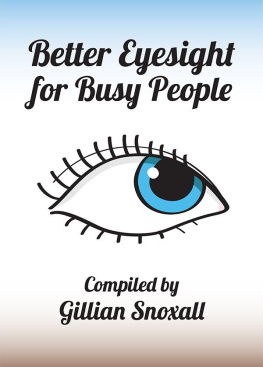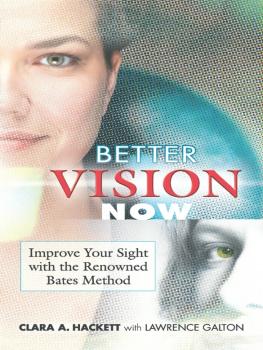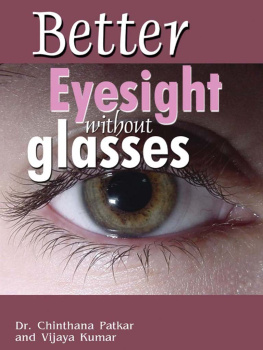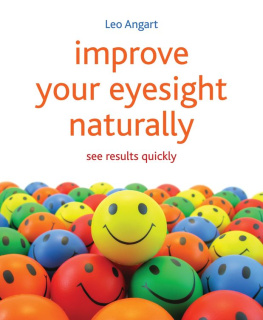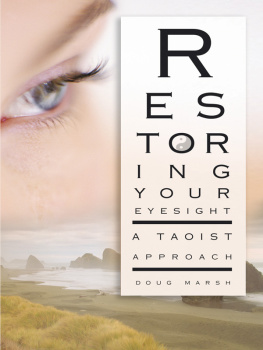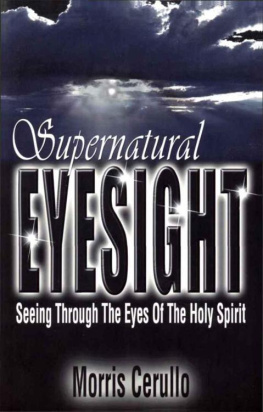Copyright 2015 by Gillian Snoxall
The right of Gillian Snoxall to be identified as the author of this work has been asserted by them in accordance with the Copyright, Designs and Patents Act 1988.
ISBN: 978-1-78324-039-5 (print)
ISBN: 978-1-78324-040-1 (ebook)
All rights reserved. Apart from any use permitted under UK copyright law, this publication may not be reproduced, stored or transmitted by any means, without prior permission of the copyright holder/publisher.
Whilst every effort has been made to ensure that the information contained within this book is correct at the time of going to press, the author and publisher can take no responsibility for the errors or omissions contained within.
All illustrations by Emily Snape, www.emilysnape.co.uk

Published by Wordzworth Publishing
www.wordzworthpublishing.com
If you do these exercises, you need never wear glasses again.
M RS I F REWEN
B ATES P RACTITIONER
H ONG K ONG 1985
I no longer bother with glasses.
J ONATHAN B ARNES
IN HIS EXCELLENT BOOK I MPROVE Y OUR E YESIGHT A G UIDE TO THE B ATES M ETHOD FOR B ETTER E YESIGHT W ITHOUT G LASSES
Contents
Acknowledgements
I remember my surprise when I noticed that our friend Harvey Oates was reading a newspaper in the dim light of the bar in our Club in Hong Kong, without glasses. When I questioned him about this transformation, he explained that he had attended a course of lessons with Mrs I Frewen, a practitioner of the Bates system of natural vision improvement, as a result of which he no longer used glasses at all.
I lost no time in signing up with Mrs Frewen, but unfortunately she was not well at the time and was about to leave Hong Kong. Nevertheless, she did give me a handful of exercises, all of which I have practised almost every day since. Doing these exercises has resulted in my having excellent eyesight and, now in my mid-eighties, I can still read even small print without glasses.
I am profoundly grateful to these three life-changers: the late Dr William Horatio Bates MD (18601931) who invented the system; to Mrs I Frewen, Bates Practitioner who started me off on the exercises; and to Harvey Oates for leading me to them.
Introduction
This compilation of easy but effective eye exercises is for all those busy people who would like to improve their eyesight naturally, but who do not have time to wade through acres of print.
Exercise 1
Getting started
Do without your glasses as much as you possibly can.
Resist the urge to put on your glasses first thing in the morning. During the day, remove them whenever you do not actually need them. At the very least, try to go without using glasses for 15 to 20 minutes per day.
These exercises are presented in large print so you can read them without your glasses.
Exercise 2
Palming
Rest your eyes by covering them gently with your hands, excluding the light, while relaxing your whole body.
Try to find a place where you can be peaceful and undisturbed. Close your eyes and cover them gently with your hands, excluding the light while consciously relaxing the whole of your body. Do this for at least five minutes at a time, as often as possible.
Eyesight is closely connected to memory, so while you are palming it is a good idea to picture in your minds eye a scene which makes you happy. See it in detail the leaves softly rustling in the trees, or the waves washing onto the shore.
Exercise 3
Sunning
With your eyes closed, turn to face the sun and make a horizontal figure-of-eight with your whole head. Then, still with your eyes closed and facing the sun, move your head from side to side, and up and down.
Behind your closed eyelids your eyes will be adjusting to the different angles of the light, and making the small shifts that are so important to strengthening your eye muscles. Start by doing this for half a minute, repeated two or three times.
Over the next week or two, gradually build up the time spent sunning until you are doing it for around five minutes per session, at least once a day if possible. (If there is no sunshine, a strong lamp can be used instead).
Important: Of course, you should never look directly at the sun, except with your eyes closed.
Exercise 4
The Big X
Make a big X with your eyes, looking to the top-right as far as you can, then down to the bottom-left as far as possible. Then do the opposite from top-left to bottom-right. Repeat four times in each direction.
Do this throughout the day, whenever you get the chance.
Exercise 5
Sunnies are a no-no!
Do without your sunglasses as much as you possibly can.
Your eyes will adjust naturally to the change in light when you go outdoors, and it is good exercise for them to do so.
The only time you might need sunglasses is when you are snow-skiing in bright sunshine.
Exercise 6
Zooming
Sitting in a comfortable position, hold a pencil at arms length in front of you, with the blunt end towards you.
Focusing on the blunt end all the time, bring the pencil up to your nose, then take it up to the top of your forehead, back down over your nose, mouth and chin to your chest.
Then bring it back up to your nose and on out to arms length again.
This exercise will strengthen your eyes ability to focus, and generally improve your eye muscles. Do it whenever you get the chance.
Exercise 7
Blinking
Perform 300 blinks. Yes, thats right: 300 blinks.
At the end of 300 blinks, do a big squeeze of your eyes, neck and shoulders.
It is easiest to count the blinks in sets of ten, thus:
One, two, three ten
One, two, three twenty
One, two, three thirty
and so on.
This exercise helps to keep your eyes fresh and better able to focus. You should do it at least once a day.
Exercise 8
Near and far focusing
Focus on a nearby object, perhaps the print of a book you are holding, then focus on some distant object such as a light switch on a far wall.
Next page
